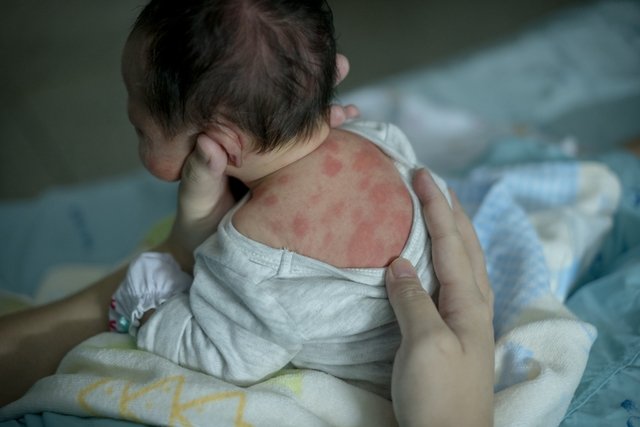Erythema toxicum is a common benign condition in newborns characterized by symptoms such as small red spots on the skin shortly after birth or after 2 days of life, mainly on the cheeks, face, chest, arms or legs.
The cause of erythema toxicum, also called erythema toxicum neonatorum, is not yet well established. However, the red spots do not cause any pain or discomfort to the baby and disappear after about two weeks without the need for any type of treatment.
However, the baby should always be evaluated by a neonatologist or pediatrician, in order to have the correct diagnosis and rule out other conditions that may have similar symptoms to this type of erythema, such as neonatal acne or herpes simplex, for example.
Sensitive content
This image may contain content that is uncomfortable for some people.

Symptoms of erythema toxicum
The main symptoms of erythema toxicum are:
- Raised and firm spots on the skin, measuring 1 to 3 mm;
- Whitish-yellow spots, with a red base and irregular outline;
- Red dots on the skin containing liquid inside;
- Skin lesions with a “flea bite” appearance
The symptoms of erythema toxicum appear a few hours after birth or within 2 days of life, and the skin lesions do not itch, cause pain or discomfort. In some cases, erythema toxicum may appear within 2 weeks of life.
Skin lesions caused by erythema toxicum are more common in areas of the body that have hair follicles, and generally begin on the cheeks and quickly spread to the forehead, face, chest, trunk, legs or arms. The palms of the hands and soles of the feet are not affected.
Normally, erythema toxicum lesions disappear and reappear in other parts of the body, and last about 10 to 14 days, improving spontaneously, without the need for specific treatment.
How to confirm the diagnosis
The diagnosis of erythema toxicum is clinical, made by a neonatologist or pediatrician, through the evaluation of symptoms and physical examination of the skin, observing the characteristics and location of the lesions, which is normally considered a normal reaction of the baby’s skin.
If the spots do not disappear after a few weeks, the doctor may recommend tests to rule out other conditions with similar symptoms, such as staphylococcal folliculitis, herpes simplex, congenital candidiasis, transient neonatal pustular melanosis or neonatal acne. Learn more about neonatal acne.
Schedule an appointment with a neonatologist in the nearest region:
Taking care of your health has never been easier!
Possible causes
The exact cause of erythema toxicum is not completely known, but it appears to be related to an immunological response that leads to skin inflammation due to microbial colonization of the baby’s skin after birth.
How the treatment is carried out
The red spots of erythema toxicum are benign and disappear naturally after 10 to 14 days without leaving any sequelae, and it is not necessary to carry out any type of specific treatment.
However, the neonatologist or pediatrician may recommend some precautions to speed up the disappearance of the spots, such as:
- Bathe once a dayavoiding excessive bathing, as the skin can become irritated and dry;
- Avoid touching the stains red skin;
- Use moisturizing creams suitable for baby’s skin, without perfume or other substances that could irritate the skin.
Furthermore, the baby can be fed or breastfed normally without the need for special nutritional care, beyond what is normal for his age.

Sign up for our newsletter and stay up to date with exclusive news
that can transform your routine!
Warning: Undefined array key "title" in /home/storelat/public_html/wp-content/plugins/link-whisper-premium/templates/frontend/related-posts.php on line 12
Warning: Undefined array key "title_tag" in /home/storelat/public_html/wp-content/plugins/link-whisper-premium/templates/frontend/related-posts.php on line 13




